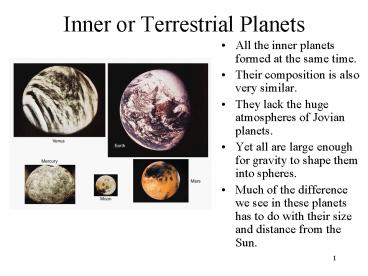Inner or Terrestrial Planets - PowerPoint PPT Presentation
1 / 12
Title:
Inner or Terrestrial Planets
Description:
Inner or Terrestrial Planets All the inner planets formed at the same time. Their composition is also very similar. They lack the huge atmospheres of Jovian planets. – PowerPoint PPT presentation
Number of Views:192
Avg rating:3.0/5.0
Title: Inner or Terrestrial Planets
1
Inner or Terrestrial Planets
- All the inner planets formed at the same time.
- Their composition is also very similar.
- They lack the huge atmospheres of Jovian planets.
- Yet all are large enough for gravity to shape
them into spheres. - Much of the difference we see in these planets
has to do with their size and distance from the
Sun.
2
Density of the Planets
- Density is simply the mass divided by the volume
(M/V). - The density of the Terrestrial planets is much
higher than for the Jovian planets. - The Jovian planets are more massive than
Terrestrial planets but their volume is much
higher so their densities are actually lower - Earth has a density of 5.52 grams/cm3, Jupiter
has a density of 1.33 grams/cm3 .
3
Planetary Interiors
- When the planets formed they were very hot. This
heat came from three sources - Accretion - impacts from asteroids and comets
- Differentiation - heavy material sinks, light
material rises - Radiation - radioactive materials
4
Planetary Interiors
- Differentiation caused the heavy materials such
as iron and nickel to sink towards the core. The
lighter material rose to the surface and cooled
forming the crust. - The interior heat of planets drives earthquakes,
volcanoes, etc. - All the planets are cooling down. The smaller the
planet, the faster the planet cools. Earth still
has a hot interior, Mercurys interior may have
cooled completely.
5
Impact Cratering
- All of the inner planets experienced tremendous
amounts of impact cratering - The number of craters in an area can be used to
tell the age of the surface. Fewer craters,
younger area. - On some planets craters have been removed by lava
flows, others by erosion. - Planets with atmospheres cause small objects to
burn up before they hit the ground. - Planets without atmospheres are continually
bombarded with dust-sized micrometeorites.
A heavily cratered area of the Moon
Barringer Meteor Crater, AZ, USA
6
Mercury
- Smallest of the inner planets. Large metallic
core. Geologically dead although magnetic field
detected. Why? - Its rotation rate is slow and is exactly 2/3 of
its orbital period. One Mercury year is 87.9
Earth days, one Mercury day is 58.6 Earth days.
This is an example of a spin-orbit resonance. - It has a very elliptical and inclined orbit.
- The surface facing the Sun is very hot because
Mercury is so close to the Sun. - However, since Mercurys axial tilt is near 0,
craters near the poles receive no sunlight and
are very cold. - Scientists may have detected ice at the poles.
- No atmosphere, no satellites.
- Unmanned missions to Mercury
- Mariner 10 (1974-75),
- MESSENGER (2011-2012),
- BepiColombo (2011-2012).
7
Venus
- Nearly the same size as Earth. Probably still
geologically active. - Completely covered in clouds. Only by radar have
we observed the surface and measured the rotation
rate. - Very thick atmosphere mostly CO2
- Runaway greenhouse effect causes very high
surface temperatures and pressures. - Hottest surface temperature of any inner planet.
Hotter than Mercury. - Surface pressure is 100 times higher than Earths
- Slowest rotation of any planet (243 days) and
spins backwards. - No magnetic field, no satellites
Radar image of Venus
- Unmanned missions to Venus
- Magellan (1989-1994)
- Pioneer Venus (1978-1992)
- Vega 1 2 (1985)
- Venera 1 - 16 (1961-1983)
- Mariner 5 (1967)
- Mariner 2 (1962)
8
The Greenhouse Effect
- When the gases in an atmosphere allow sunlight to
strike the surface the surface heats up and gives
off infrared radiation. - If the atmosphere however prevents the infrared
radiation from radiating back out to space the
temperature of the planet can increase, this is
the Greenhouse Effect. - Carbon Dioxide CO2 behaves this way and is an
important greenhouse gas. Venus atmosphere is
95 CO2.
9
Earth
- Large enough to maintain hot interior (volcanoes,
earthquakes, continental drift). - Thick atmosphere and mild greenhouse effect
allows liquid water to remain on the surface. - Erosion has eliminated nearly all impact craters.
- Rapid spin and molten interior allow a magnetic
field to exist. - One satellite, Moon.
Earth and Moon as seen from Martian orbit
Earth as seen from Lunar orbit
10
Mars
- About half the size of Earth. No geological
activity likely now. No magnetic field. - Has the largest volcano in the solar system,
Olympus Mons. - Evidence of massive water erosion some time in
the past. Scientists are searching for liquid
water now. - Very thin CO2 atmosphere, polar caps of mostly
frozen CO2 and water. Since its atmosphere is
thin and cold there is very little greenhouse
effect. - Two satellites, Phobos and Deimos (possibly
captured asteroids)
Nearly 40 unmanned missions to Mars since 1960
Olympus Mons
11
The Search for Life on Mars
- Among all of the planets besides Earth, Mars
appears to have had conditions that might have
been most suitable for life. - What appear to be dry lake beds and water erosion
on Mars are visible from orbit. - If liquid water once existed on the surface of
Mars did life also? Might it still be there? - The current series of Mars Exploration Rovers are
on the surface looking at the geology of Mars to
find chemical and physical evidence of water. - Their results are that liquid water had existed
on Mars at some time in the past.
12
Unmanned Missions to Mars Surface
Sojourner/Pathfinder (1997)
Spirit Opportunity MER (2004-2005)
Viking 12 (1976)































